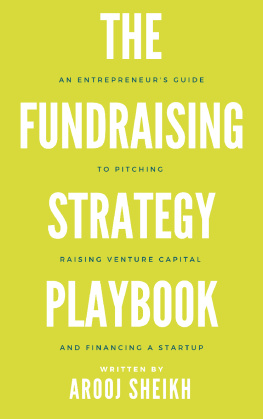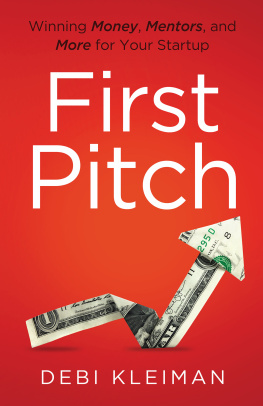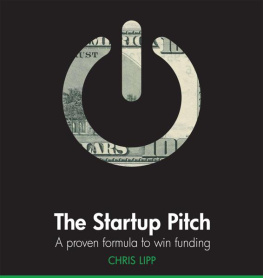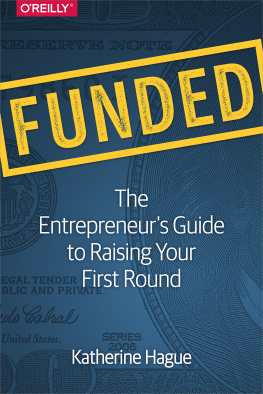Haje Jan Kamps - Pitch Perfect: Raising Capital for Your Startup
Here you can read online Haje Jan Kamps - Pitch Perfect: Raising Capital for Your Startup full text of the book (entire story) in english for free. Download pdf and epub, get meaning, cover and reviews about this ebook. publisher: Apress, genre: Business. Description of the work, (preface) as well as reviews are available. Best literature library LitArk.com created for fans of good reading and offers a wide selection of genres:
Romance novel
Science fiction
Adventure
Detective
Science
History
Home and family
Prose
Art
Politics
Computer
Non-fiction
Religion
Business
Children
Humor
Choose a favorite category and find really read worthwhile books. Enjoy immersion in the world of imagination, feel the emotions of the characters or learn something new for yourself, make an fascinating discovery.
- Book:Pitch Perfect: Raising Capital for Your Startup
- Author:
- Publisher:Apress
- Genre:
- Rating:5 / 5
- Favourites:Add to favourites
- Your mark:
- 100
- 1
- 2
- 3
- 4
- 5
Pitch Perfect: Raising Capital for Your Startup: summary, description and annotation
We offer to read an annotation, description, summary or preface (depends on what the author of the book "Pitch Perfect: Raising Capital for Your Startup" wrote himself). If you haven't found the necessary information about the book — write in the comments, we will try to find it.
Pitch Perfect: Raising Capital for Your Startup — read online for free the complete book (whole text) full work
Below is the text of the book, divided by pages. System saving the place of the last page read, allows you to conveniently read the book "Pitch Perfect: Raising Capital for Your Startup" online for free, without having to search again every time where you left off. Put a bookmark, and you can go to the page where you finished reading at any time.
Font size:
Interval:
Bookmark:


Any source code or other supplementary material referenced by the author in this book is available to readers on GitHub via the books product page, located at www.apress.com/978-1-4842-6064-7 . For more detailed information, please visit http://www.apress.com/source-code .
For founders.
You say yes to a hell of a journey.
You have it. The perfect idea for a company is crystallizing in your mind. Early research indicates that the journey you are embarking on could be both fun, challenging, lucrative, and engaging. Things are coming together beautifully. And now its time to raise some money.
This book is focused on the pitch process; it is a guide to how to put together an extraordinary pitch. It will help you create an excellent narrative for your potential investors. But it is much more, too. It will help explain what parts of the story will be most potent in how you can raise money. It will discuss different ways of thinking about how to craft your story and how you can catch your target audience by surprise.
As with all great storytelling, you need to know your audience. You have to understand how investors think and what the driving forces are behind making an investment. To successfully raise money from institutional investors, you need to understand how venture capital (VC) works (Chapter ).
Fundraising is a complicated process with many moving parts. Buried deep in the intersection of the people youve attracted to help build your business, the market youre going to be operating in, and the problem you are solving, theres a story. You are going to move the world from where you are today to the universe you can imagine in the future. To do that, youre going to deploy some resources, including money.
A startup fundraising pitch is designed to do one thing exceptionally effectively: paint a comprehensive picture of your company and the economy it operates in. Your potential investors will look at your pitch deck and listen to your pitch. A compelling story will make investors lean in and hitch their wagon to your dreams. An excellent presentation anticipates everything an investor will want to know about your venture. Both the greatthe things you are better at than anybody elseand the not-so-great. In this book, I will dissect all the slides that typically appear in support of a pitch deck. I will talk about the things that throw up red flags for investors and about the things that are positive indicators for fundraising. I will take you behind the scenes of the decision-making process investors use to help you craft the best story possible.
The truth is that pitching is brutal: Laying your whole business bare in under 20 minutes means that theres no space for fluff, and there will be very little to hide behind. Investors see dozens of pitches per week and are extraordinarily attuned to how this format works. If you are padding or beating about the bush, if youre lucky, they will call you on it. If you are less fortunate, the investors will tune out and mentally write you off long before you make it to the end of your story.
When I do pitch coaching, the nowhere to hide aspect becomes apparent all the time. Sometimes, when a founder stumbles over a slide or a part of the story, theres a simple fix. Perhaps a point needs to be set up earlier in the presentation. Maybe the story is cleaner if you dont delve as deep into a particular aspect of the business.
Surprisingly often, though, working with founders on their pitch decks doesnt show the shortcomings of the presentations. Instead, it reveals cracks in the foundation of the company itselfflaws in the go-to-market strategy and/or weaknesses in the team. Market dynamics that dont pan out or obvious flaws in the pricing or business model that prevent the business from being viable. A book cant cover every eventuality in where your company goes wrongthats where my coaching practice comes inbut I will teach you the thought processes to help you self-assess.
You cant trust investors to tell you where your story falls apart. They are incredibly busy people. Some investors are willing to give you a nudge in the right direction, but in my experience, they dont have the bandwidth to engage in a long back-and-forth to fully ascertain the challenges in your pitch. They are in the business of investing and helping grow the 0.5% of companies they end up investing in, not fixing the underlying architectural challenges in the 99.5% they choose not to invest in.
Many investors are much more likely to give you a soft no, which usually comes in the form of a "youre too early for us to invest," or "we dont focus on this market right now," or "please check back with us when you have some more traction." The complicated thing about the soft no is that it may be genuine: the investment firm may really want you to check back when you have a bit more traction, or they may actually be defocusing from the market you are talking about. However, investors are in the business of finding extraordinary humans building spectacular companies. In my experience, they will engage in conversations with companies, even if they arent a slam dunk, if the opportunity is good enough. FOMO (fear of missing out) runs deep in the venture world, and a lot of the time, however, the soft no serves another purpose. It exists to help the firm have an option to talk to you again further down the line. If you find yourself getting a lot of soft nos, it probably means that theres something about the business thats not fully working.
Font size:
Interval:
Bookmark:
Similar books «Pitch Perfect: Raising Capital for Your Startup»
Look at similar books to Pitch Perfect: Raising Capital for Your Startup. We have selected literature similar in name and meaning in the hope of providing readers with more options to find new, interesting, not yet read works.
Discussion, reviews of the book Pitch Perfect: Raising Capital for Your Startup and just readers' own opinions. Leave your comments, write what you think about the work, its meaning or the main characters. Specify what exactly you liked and what you didn't like, and why you think so.











